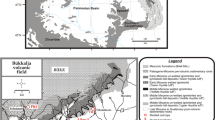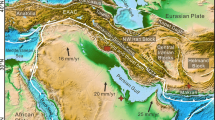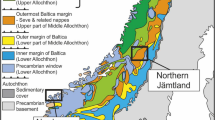Abstract
The Austurhorn intrusive complex (AIC) in southeast Iceland comprises large bodies of granophyre and gabbro, and a mafic–silicic composite zone (MSCZ) that exemplifies magmatic interactions common in Icelandic silicic systems. Despite being one of Iceland’s best-studied intrusions, few studies have included detailed analyses of zircon, a mineral widely recognized as a valuable tracer of the history and evolution of its parental magma(s). In this study, we employ high spatial resolution zircon elemental and isotopic geochemistry and U–Pb geochronology as tools for elucidating the complex construction and magmatic evolution of Austurhorn’s MSCZ. The trace element compositions of AIC zircon crystals form a broad but coherent array that partly overlaps with the geochemical signature for zircons from Icelandic silicic volcanic rocks. Typical of Icelandic zircons, Hf concentrations are relatively low (<10,000 ppm) and Ti concentrations range from 5 to 40 ppm (Ti-in-zircon model temperatures = 761–981 °C). Zircon δ18O values vary from +2.2 to +4.8 ‰, consistent with magmatic zircons from other Icelandic silicic rocks, and preserve evidence for recycling of hydrothermally altered crust as a significant contribution to the generation of silicic magmas within the AIC. Zircon ε Hf values generally range from +11 to +15. This range overlaps with that of Icelandic basalts from off-rift settings as well as the least depleted rift basalts, suggesting that the AIC developed within a transitional rift environment. In situ zircon U–Pb ages yield a weighted mean of 6.52 ± 0.03 Ma for the entire complex, but span a range of ~320 kyr, from 6.35 ± 0.08 to 6.67 ± 0.06 Ma (2σ SE). Gabbros and the most silicic units make up the older part of this range, while granophyres and intermediate units make up the younger part of the complex, consistent with field relationships. We interpret the ~320 kyr range in zircon ages to represent the approximate timescale of magmatic construction of the MSCZ. These U–Pb data suggest that the complex was constructed by multiple short-lived magmatic intrusion events occurring closely spaced in time, allowing periodic re-melting and rejuvenation of mush-like material and a prolonged lifetime for the complex.











Similar content being viewed by others
References
Barth AP, Wooden JL (2010) Coupled elemental and isotopic analyses of polygenetic zircons from granitic rocks by ion microprobe, with implications for melt evolution and the sources of granitic magmas. Chem Geol 277(1–2):149–159
Bindeman I (2008) Oxygen isotopes in mantle and crustal magmas as revealed by single crystal analysis. In: Putirka KD, Tepley FJ (eds) Minerals, inclusions and volcanic processes. Reviews in mineralogy and geochemistry, vol 69. Mineralogical Society of America, Washington, DC, pp 602–622
Bindeman I, Gurenko A, Sigmarsson O, Chaussidon M (2008) Oxygen isotope heterogeneity and disequilibria of olivine crystals in large volume Holocene basalts from Iceland: evidence for magmatic digestion and erosion of Pleistocene hyaloclastites. Geochim Cosmochim Acta 72:4397–4420
Bindeman I, Gurenko A, Carley TL, Miller CF, Martin E, Sigmarsson O (2012) Silicic magma petrogenesis in Iceland by remelting of hydrothermally altered crust based on oxygen isotope diversity and disequilibria between zircon and magma with implications for MORB. Terra Nova 24(3):227–232
Black LP, Kamo SL, Allen CM, Davis DW, Aleinikoff JN, Valley JW, Mundil R, Campbell IH, Korsuch RJ, Williams IS, Foudoulis C (2004) Improved 206Pb/238U microprobe geochronology by the monitoring of a trace-element-related matrix effect; SHRIMP, ID–TIMS, ELA–ICP–MS and oxygen isotope documentation for a series of zircon standards. Chem Geol 205:115–140
Blake DH (1966) Net-veined complex of Austurhorn Intrusion, Southeastern Iceland. Geology 74(6):891–907
Blake DH (1970) Geology of Alftafjordur volcano, a Tertiary volcanic centre in South-Eastern Iceland. Sci Isl 2:43–63
Boehnke P, Watson EB, Trail D, Harrison TM, Schmitt AK (2013) Zircon saturation re-visited. Chem Geol 351:324–334
Bouvier A, Vervoort JD, Patchett PJ (2008) The Lu–Hf and Sm–Nd isotopic composition of CHUR: constraints from unequilibrated chondrites and implications for the bulk composition of terrestrial planets. Earth Planet Sci Lett 273:48–57
Carley TL, Miller CF, Wooden JL, Bindeman IN, Barth AP (2011) Zircon from historic eruptions in Iceland: reconstructing storage and evolution of silicic magmas. Mineral Petrol 102:135–161
Carley TL, Miller CF, Wooden JL, Padilla AJ, Schmitt AK, Economos RC, Bindeman IN, Jordan BT (2014) Iceland is not a magmatic analog for the Hadean: evidence from the zircon record. Earth Planet Sci Lett 405:85–97
Cherniak DJ, Watson EB (2000) Pb diffusion in zircon. Chem Geol 172:5–24
Cherniak DJ, Watson EB (2007) Ti diffusion in zircon. Chem Geol 242:470–483
Cherniak DJ, Hanchar JM, Watson EB (1997a) Diffusion of tetravalent cations in zircon. Contrib Miner Petrol 127:383–390
Cherniak DJ, Hanchar JM, Watson EB (1997b) Rare-earth diffusion in zircon. Chem Geol 134:289–301
Claiborne LL, Miller CF, Walker BA, Wooden JL, Mazdab FK, Bea F (2006) Tracking magmatic processes through Zr/Hf ratios in rocks and Hf and Ti zoning in zircons: an example from the Spirit Mountain batholith, Nevada. Mineral Mag 70(5):517–543
Claiborne LL, Miller CF, Flanagan DM, Clynne MA, Wooden JL (2010a) Zircon reveals protracted magma storage and recycling beneath Mount St. Helens. Geology 38(11):1011–1014
Claiborne LL, Miller CF, Wooden JL (2010b) Trace element composition of igneous zircon: a thermal and compositional record of the accumulation and evolution of a large silicic batholith, Spirit Mountain, Nevada. Contrib Miner Petrol 160:511–531
Corfu F, Hanchar JM, Hoskin PWO, Kinny P (2003) Atlas of zircon textures. In: Hanchar JM, Hoskin PWO (eds) Zircon. Reviews in mineralogy and geochemistry, vol 53. Mineralogical Society of America, Washington, DC, pp 27–62
Drew DL, Bindeman IN, Watts KE, Schmitt AK, Fu B, McCurry M (2013) Crustal-scale recycling in caldera complexes and rift zones along the Yellowstone hotspot track: O and Hf isotopic evidence in diverse zircons from voluminous rhyolites of the Picabo volcanic field, Idaho. Earth Planet Sci Lett 381:63–77
Ferry JM, Watson EB (2007) New thermodynamic models and revised calibrations for the Ti-in-zircon and Zr-in-rutile thermometers. Contrib Miner Petrol 154:429–437
Fisher CM, Hanchar JM, Samson SD, Dhuime B, Blichert-Toft J, Vervoort JD, Lam R (2011) Synthetic zircon doped with hafnium and rare earth elements: a reference material for in situ hafnium isotope analysis. Chem Geol 286(1):32–47
Fisher CM, Vervoort JD, Hanchar JM (2014) Guidelines for reporting zircon Hf isotopic data by LA–MC–ICPMS and potential pitfalls in the interpretation of these data. Chem Geol 363:125–133
Furman TH (1989) Evolution of Icelandic central volcanoes: evidence from the Austurhorn Plutonic and Vestmannaeyjar volcanic complexes. Ph.D. Dissertation, Massachusetts Institute of Technology/Woods Hole Oceanographic Institution Joint Program, 373 pp
Furman T, Meyer PS, Frey FA (1992a) Evolution of Icelandic central volcanoes: evidence from the Austurhorn intrusion, southeastern Iceland. Bull Volc 55:45–62
Furman T, Frey FA, Meyer PS (1992b) Petrogenesis of evolved basalts and rhyolites at Austurhorn, southeastern Iceland: the role of fractional crystallization. J Petrol 33:1405–1445
Gale NH, Moorbath S, Simons J, Walker GPL (1966) K–Ar ages of acid intrusive rocks from Iceland. Earth Planet Sci Lett 1:284–288
Gautason B, Muehlenbachs K (1998) Oxygen isotopic fluxes associated with high-temperature processes in the rift zones of Iceland. Chem Geol 145:275–286
Ghiorso MS, Gualda GAR (2013) A method for estimating the activity of titania in magmatic liquids from the compositions of coexisting rhombohedral and cubic iron–titanium oxides. Contrib Miner Petrol 165:73–81
Grimes CB, John BE, Kelemen PB, Mazdab FK, Wooden JL, Cheadle MJ, Hanghøj K, Schwartz JJ (2007) Trace element chemistry of zircons from oceanic crust: a method for distinguishing detrital zircon provenance. Geology 35(7):643–646
Grimes CB, Wooden JL, Cheadle MJ, John BE (2015) “Fingerprinting” tectono-magmatic provenance using trace elements in igneous zircon. Contrib Miner Petrol 170:46
Gunnarsson B, Marsh BD, Taylor HP (1998) Generation of Icelandic rhyolites: silicic lavas from the Torfajokull central volcano. J Volcanol Geoth Res 83:1–45
Gurenko AA, Bindeman IN, Sigurdsson IA (2015) To the origin of Icelandic rhyolites: insights from partially melted leucocratic xenoliths. Contrib Miner Petrol 169:49
Harper BE, Miller CF, Koteas GC, Cates NL, Wiebe RA, Lazzareschi DS, Cribb JW (2004) Granites, dynamic magma chamber processes and pluton construction: the Aztec Wash pluton, Eldorado Mountains, Nevada, USA. Trans R Soc Edinb Earth Sci 95:277–295
Harrison TM, Watson EB, Aikman AB (2007) Temperature spectra of zircon crystallization in plutonic rocks. Geology 35(7):635–638
Hoskin PWO, Schaltegger U (2003) The composition of zircon and igneous and metamorphic petrogenesis. In: Hanchar JM, Hoskin PWO (eds) Zircon. Reviews in Mineralogy and Geochemistry, vol 53. Mineralogical Society of America, Washington DC, pp 27–62
Jónasson K (2007) Silicic volcanism in Iceland: composition and distribution within the active volcanic zones. J Geodyn 43:101–117
Kemp AIS, Hawkesworth CJ, Foster GL, Paterson BA, Woodhead JD, Hergt JM, Gray CM, Whitehouse MJ (2007) Magmatic and crustal differentiation history of granitic rocks from Hf–O isotopes in zircon. Science 315(5814):980–983
Ludwig KR (2009) Unpublished–SQUID 2 data reduction program. Berkeley Geochronology Center. http://www.bgc.org/isoplot_etc/squid.html
Maclennan J, McKenzie D, Grönvold K, Shimizu N, Eiler JM, Kitchen N (2003) Melt mixing and crystallization under Theistareykir, northeast Iceland. Geochem Geophys Geosyst 4(11):8624
Mahon KI (1996) The New “York” regression: application of an improved statistical method to geochemistry. Int Geol Rev 38:293–303
Martin E, Sigmarsson O (2007) Crustal thermal state and origin of silicic magma in Iceland: the case of Torfajökull, Ljósufjöll and Snæfellsjökull volcanoes. Contrib Miner Petrol 153:593–605
Martin E, Sigmarsson O (2010) Thirteen million years of silicic magma production in Iceland: links between petrogenesis and tectonic settings. Lithos 116:129–144
Martin E, Paquette JL, Bosse V, Ruffet G, Tiepolo M, Sigmarsson O (2011) Geodynamics of rift-plume interaction in Iceland as constrained by new 40Ar/39Ar and in situ U–Pb zircon ages. Earth Planet Sci Lett 311:28–38
Mattson SR, Vogel TA, Wilband JT (1986) Petrochemistry of the silicic–mafic complexes at Vesturhorn and Austurhorn, Iceland: evidence for zoned/stratified magma. J Volcanol Geoth Res 28:197–223
McDowell SM, Miller CF, Mundil R, Ferguson CA, Wooden JL (2014) Zircon evidence for a ~200 k.y. supereruption-related thermal flare-up in the Miocene southern Black Mountains, western Arizona, USA. Contrib Miner Petrol 168:1031
Miller CF, McDowell SM, Mapes RW (2003) Hot and cold granites? Implications of zircon saturation temperatures and preservation of inheritance. Geology 31:529–532
Moecher DP, McDowell SM, Samson SD, Miller CF (2014) Ti-in-zircon thermometry and crystallization modeling support hot Grenville granite hypothesis. Geology 42:267–270
Moorbath S, Sigurdsson H, Goodwin R (1968) K–Ar ages of the oldest exposed rocks in Iceland. Earth Planet Sci Lett 4:197–205
Padilla AJ (2015) Elemental and isotopic geochemistry of crystal-melt systems: elucidating the construction and evolution of silicic magmas in the shallow crust, using examples from southeast Iceland and southwest USA. Ph.D. Dissertation, Vanderbilt University
Pamukcu AS, Carley TL, Gualda GAR, Miller CF, Ferguson CA (2013) The evolution of the Peach Spring giant magma body: evidence from accessory mineral textures and compositions, bulk pumice and glass geochemistry, and rhyolite-MELTS modeling. J Petrol 54:1109–1148
Peate DW, Breddam K, Barker JA, Kurz MD, Barker AK, Prestvik T, Grassineau N, Skovgaard AC (2010) Compositional characteristics and spatial distribution of enriched Icelandic mantle components. J Petrol 51(7):1447–1475
Pope EC, Bird DK, Arnorsson S (2013) Evolution of low-O-18 Icelandic crust. Earth Planet Sci Lett 374:47–59
Ross JG, Mussett AE (1976) 40Ar/39Ar dates for spreading rates in eastern Iceland. Nature 259(5538):36–38
Sigmarsson O, Hémond C, Condomines M, Fourcade S, Oskarsson N (1991) Origin of silicic magma in Iceland revealed by Th isotopes. Geology 19:621–624
Thirlwall MF, Gee MAM, Lowry D, Mattey DP, Murton BJ, Taylor RN (2006) Low d18O in the Icelandic mantle and its origins: evidence from Reykjanes Ridge and Icelandic lavas. Geochim Cosmochim Acta 70:993–1019
Thorarinsson SB, Tegner C (2009) Magma chamber processes in central volcanic systems of Iceland: constraints from layered gabbro of the Austurhorn intrusive complex. Contrib Miner Petrol 158:223–244
Thordarson T, Höskuldsson A (2002) Iceland–classic geology in Europe 3. Terra Publishing, Edinburgh
Trail D, Mojzsis SJ, Harrison TM, Schmitt AK, Watson EB, Young ED (2007) Constraints on Hadean zircon protoliths from oxygen isotopes, Ti-thermometry, and rare earth elements. Geochem Geophys Geosyst 8:22
Valley JW (2003) Oxygen isotopes in zircon. In: Hanchar JM, Hoskin PWO (eds) Zircon. Reviews in mineralogy and geochemistry, vol 53. Mineralogical Society of America, Washington, DC, pp 344–385
Valley JW, Kinny PD, Schulze DJ, Spicuzza MJ (1998) Zircon megacrysts from kimberlite: oxygen isotope variability among mantle melts. Contrib Miner Petrol 133:1–11
Veblem DR, Buseck PR (1981) Hydrous pyriboles and sheet silicates in pyroxenes and uralites: intergrowth microstructures and reaction mechanisms. Am Mineral 66:1107–1134
Vernon RH (1984) Microgranitoid enclaves in granites—globules of hybrid magma quenched in a plutonic environment. Nature 309(5967):438–439
Vervoort JD, Blichert-Toft J (1999) Evolution of the depleted mantle: Hf isotope evidence from juvenile rocks through time. Geochim Cosmochim Acta 63:533–556
Walker GPL (1960) Zeolite zones and dike distribution in relation to the structure of the basalts of eastern Iceland. J Geol 68:515–527
Walker GPL (1964) Geological investigations in eastern Iceland. Bull Volc 27:1–15
Walker GPL (1966) Acid volcanic rocks in Iceland. Bull Volc 29:375–402
Watson EB, Cherniak DJ (1997) Oxygen diffusion in zircon. Earth Planet Sci Lett 148(3–4):527–544
Watson EB, Harrison TM (1983) Zircon saturation revisited: temperature and composition effects in a variety of crustal magma types. Earth Planet Sci Lett 64:295–304
Weidendorfer D, Mattsson HB, Ulmer P (2014) Dynamics of magma mixing in partially crystallized magma chambers: textural and petrological constraints from the basal complex of the Austurhorn Intrusion (SE Iceland). J Petrol 55(9):1865–1903
Wiebe RA, Collins WJ (1998) Depositional features and stratigraphic sections in granitic plutons: implications for the emplacement and crystallization of granitic magma. J Struct Geol 20(9/10):1273–1289
Wiebe RA, Blair KD, Hawkins DP, Sabine CP (2002) Mafic injections, in situ hybridization, and crystal accumulation in the Pyramid Peak granite, California. Geol Soc Am Bull 114:909–920
Wiebe RA, Manon MR, Hawkins DP, McDonough WF (2004) Late-stage mafic injection and thermal rejuvenation of the Vinalhaven Granite, Coastal Maine. J Petrol 45(11):2133–2153
Woodhead JD, Hergt JM (2005) A preliminary appraisal of seven natural zircon reference materials for in situ Hf isotope determination. Geostand Geoanal Res 29(2):183–195
Acknowledgments
We are grateful to Tanya Furman for her guidance in the planning stages of the Austurhorn project. We thank Aaron Covey (Vanderbilt University), Diane Wilford (Washington State University), Charles Knaack (Washington State University), Brad Ito (Stanford-USGS SHRIMP-RG Lab), and Rebecca Lam (Memorial University of Newfoundland) for their assistance in analytical work. We also thank Guilherme Gualda for his insightful comments and generous review of an earlier version of this manuscript and two anonymous reviewers for their valuable feedback as well as editor Dr. Timothy Grove for guidance during the review process. This work was made possible by the financial support of the National Science Foundation (Research Grant EAR-1220523), the Geological Society of America (Graduate Student Research Grant #9264-10), and the Vanderbilt University Department of Earth Sciences. The ion microprobe facility at UCLA is partly supported by a grant from the Instrumentation and Facilities Program, Division of Earth Sciences, National Science Foundation.
Author information
Authors and Affiliations
Corresponding author
Additional information
Communicated by Timothy L. Grove.
Electronic supplementary material
Below is the link to the electronic supplementary material.
Rights and permissions
About this article
Cite this article
Padilla, A.J., Miller, C.F., Carley, T.L. et al. Elucidating the magmatic history of the Austurhorn silicic intrusive complex (southeast Iceland) using zircon elemental and isotopic geochemistry and geochronology. Contrib Mineral Petrol 171, 69 (2016). https://doi.org/10.1007/s00410-016-1279-z
Received:
Accepted:
Published:
DOI: https://doi.org/10.1007/s00410-016-1279-z




